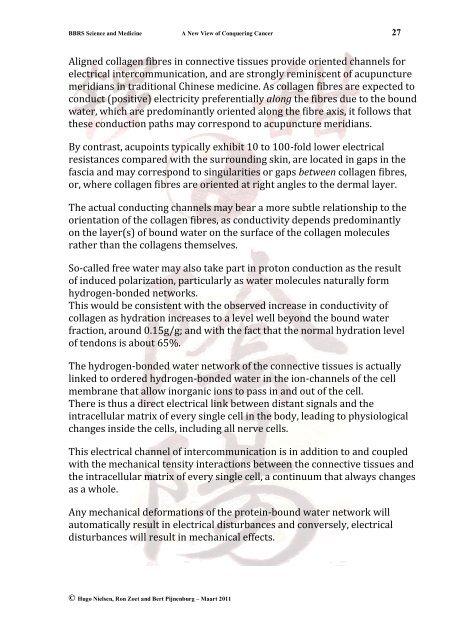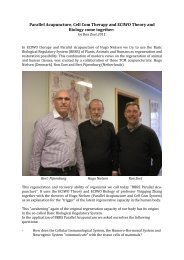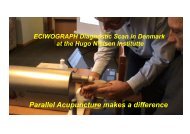BBRS SCIENCE AND MEDICINE RON ZOET Biocommunication ...
BBRS SCIENCE AND MEDICINE RON ZOET Biocommunication ...
BBRS SCIENCE AND MEDICINE RON ZOET Biocommunication ...
Create successful ePaper yourself
Turn your PDF publications into a flip-book with our unique Google optimized e-Paper software.
<strong>BBRS</strong> Science and Medicine A New View of Conquering Cancer 27<br />
Aligned collagen fibres in connective tissues provide oriented channels for<br />
electrical intercommunication, and are strongly reminiscent of acupuncture<br />
meridians in traditional Chinese medicine. As collagen fibres are expected to<br />
conduct (positive) electricity preferentially along the fibres due to the bound<br />
water, which are predominantly oriented along the fibre axis, it follows that<br />
these conduction paths may correspond to acupuncture meridians.<br />
By contrast, acupoints typically exhibit 10 to 100-fold lower electrical<br />
resistances compared with the surrounding skin, are located in gaps in the<br />
fascia and may correspond to singularities or gaps between collagen fibres,<br />
or, where collagen fibres are oriented at right angles to the dermal layer.<br />
The actual conducting channels may bear a more subtle relationship to the<br />
orientation of the collagen fibres, as conductivity depends predominantly<br />
on the layer(s) of bound water on the surface of the collagen molecules<br />
rather than the collagens themselves.<br />
So-called free water may also take part in proton conduction as the result<br />
of induced polarization, particularly as water molecules naturally form<br />
hydrogen-bonded networks.<br />
This would be consistent with the observed increase in conductivity of<br />
collagen as hydration increases to a level well beyond the bound water<br />
fraction, around 0.15g/g; and with the fact that the normal hydration level<br />
of tendons is about 65%.<br />
The hydrogen-bonded water network of the connective tissues is actually<br />
linked to ordered hydrogen-bonded water in the ion-channels of the cell<br />
membrane that allow inorganic ions to pass in and out of the cell.<br />
There is thus a direct electrical link between distant signals and the<br />
intracellular matrix of every single cell in the body, leading to physiological<br />
changes inside the cells, including all nerve cells.<br />
This electrical channel of intercommunication is in addition to and coupled<br />
with the mechanical tensity interactions between the connective tissues and<br />
the intracellular matrix of every single cell, a continuum that always changes<br />
as a whole.<br />
Any mechanical deformations of the protein-bound water network will<br />
automatically result in electrical disturbances and conversely, electrical<br />
disturbances will result in mechanical effects.<br />
© Hugo Nielsen, Ron Zoet and Bert Pijnenburg – Maart 2011





